Director’s Welcome
Read More


Michael L. Thomas, Ph.D. Director Edith O’Donnell Institute of Art History (EODIAH), Edith O’Donnell Distinguished University Chair, Professor of Arts and Humanities, Co-Director, The Oplontis Project Co-Director, Mugello Valley Archaeological Project
AS WE LOOK FORWARD TO A BRIGHT 2021 for the Edith O’Donnell Institute of Art History at UT Dallas, we do so with the sobering year of 2020 still fresh in the rearview mirror. The pandemic not only halted our in-person programming, meetings, and teaching, but also grounded those of us who rely on foreign travel for our research. Of course, such interruptions are global in their impact and are certainly not specific to EODIAH.
What made 2020 particularly difficult for us was losing our two founders, Edith O’Donnell and Rick Brettell. There has been much written that celebrates the impactful lives of these two remarkable human beings—so I will not go into detail here—but suffice to say that as we move forward into both a new year and new era for EODIAH, we do so with fond memories of both Edith and Rick looming large in our minds.
There is a bright glow on the horizon. Just recently, President Benson announced that UT Dallas plans to resume normal operations in the fall, and that means a return to in-person learning and programming. Add to that the fact that we are busy working with architects at Morphosis on the design of what promises to be a spectacular Athenaeum complex at UT Dallas, the long-time vision of Rick Brettell, whose occupants will include the Crow Museum of Asian Art, the Barrett Collection of Swiss Art, and the Brettell Reading Room. The Athenaeum will eventually include a performance hall, additional museums and an outdoor plaza, creating a new north Dallas area arts district here on the UT Dallas campus.
Personally, I am busy at work on an exhibition that will feature Dallas photographer Carolyn Brown’s spectacular images of ancient Palmyra, the Syrian Roman city whose beautiful monuments were recently destroyed by ISIS. Although I hope to see many of you before, I look forward to welcoming—in person—everyone to that show in October 2021. In the meantime, I do hope you take the time to read this newsletter as it chronicles much of the recent successes and future goals of our faculty, staff and students.
Michael Thomas
Director
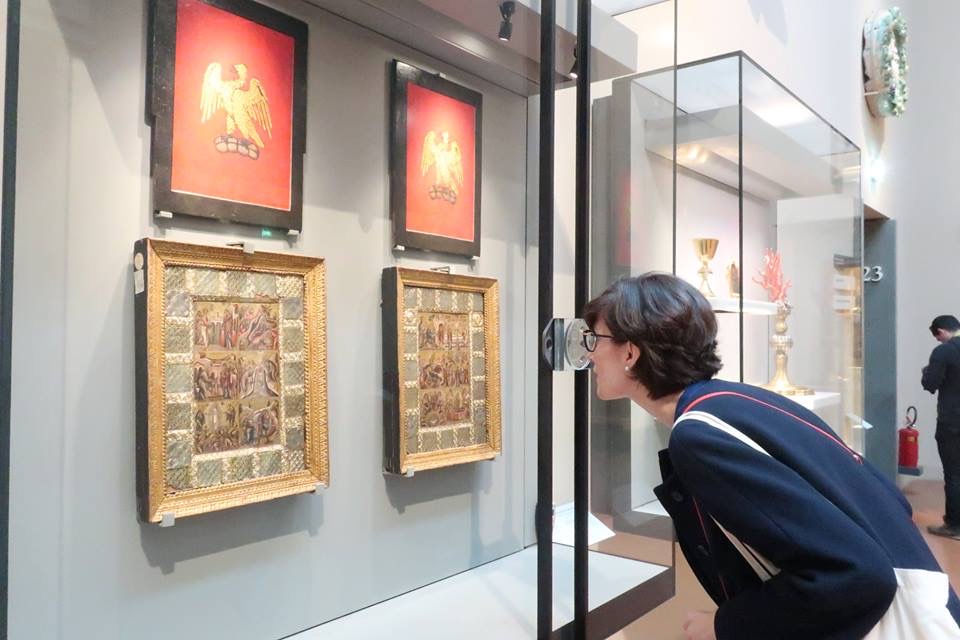
Dr. Sarah K. Kozlowski, Associate Director of The Edith O’Donnell Institute of Art History, studying a Byzantine micromosaic diptych at the Museo dell’Opera del Duomo in Florence.
IN THE YEAR SINCE THE ONSET OF THE Covid-19 pandemic, as we have navigated a world transformed, I have learned that the O’Donnell Institute’s satellite research center at the Museo di Capodimonte in Naples is not just a physical place. It is also a set of ideas and questions that emerge from shared objects of study and that are brought to life by a community of scholars. In that spirit, scattered though we are at the moment, the work of the Center for the Art and Architectural History of Port Cities continues from afar.
Since we temporarily closed the doors of La Capraia last year, we have mounted a series of digital lectures and research seminars in which scholars affiliated with the Center have shared and discussed their ongoing work. These gatherings around the digital seminar table, across multiple time zones, have been tremendously stimulating and heartening. With the Center’s partner institutions, we continue to develop programs, projects, and collaborations that advance our research mission. And with renewed dedication to our laboratory for art history that has sprung up in the heart of the Bosco, the O’Donnell Institute and Capodimonte are working together to chart the future course of the Center.
We look forward to reconvening in Naples as soon as we can. Until then, I am delighted to share with you our 2019-2020 research report. This second annual overview of our activities will give you an idea of all our accomplishments so far, and how much potential the future holds. For making all our work possible, I am especially grateful to two people we lost this past year, just months apart.
Edith O’Donnell’s bold vision and commitment to direct encounters with works of art continue to animate the Institute founded in her name.
Our Founding Director Rick Brettell, with his endless curiosity and energy, continues to be a wind at our backs. Just days before his death, Rick visited the glorious exhibition of Baroque masterpieces from the Capodimonte at the Kimbell Museum in Fort Worth. I am happy to know that those marvels from Naples were among the last works of art that Rick saw and thought about.
Dr. Sarah K. Kozlowski
Associate Director, The Edith O’Donnell Institute of Art History, Director, Center for the Art and Architectural History of Port Cities
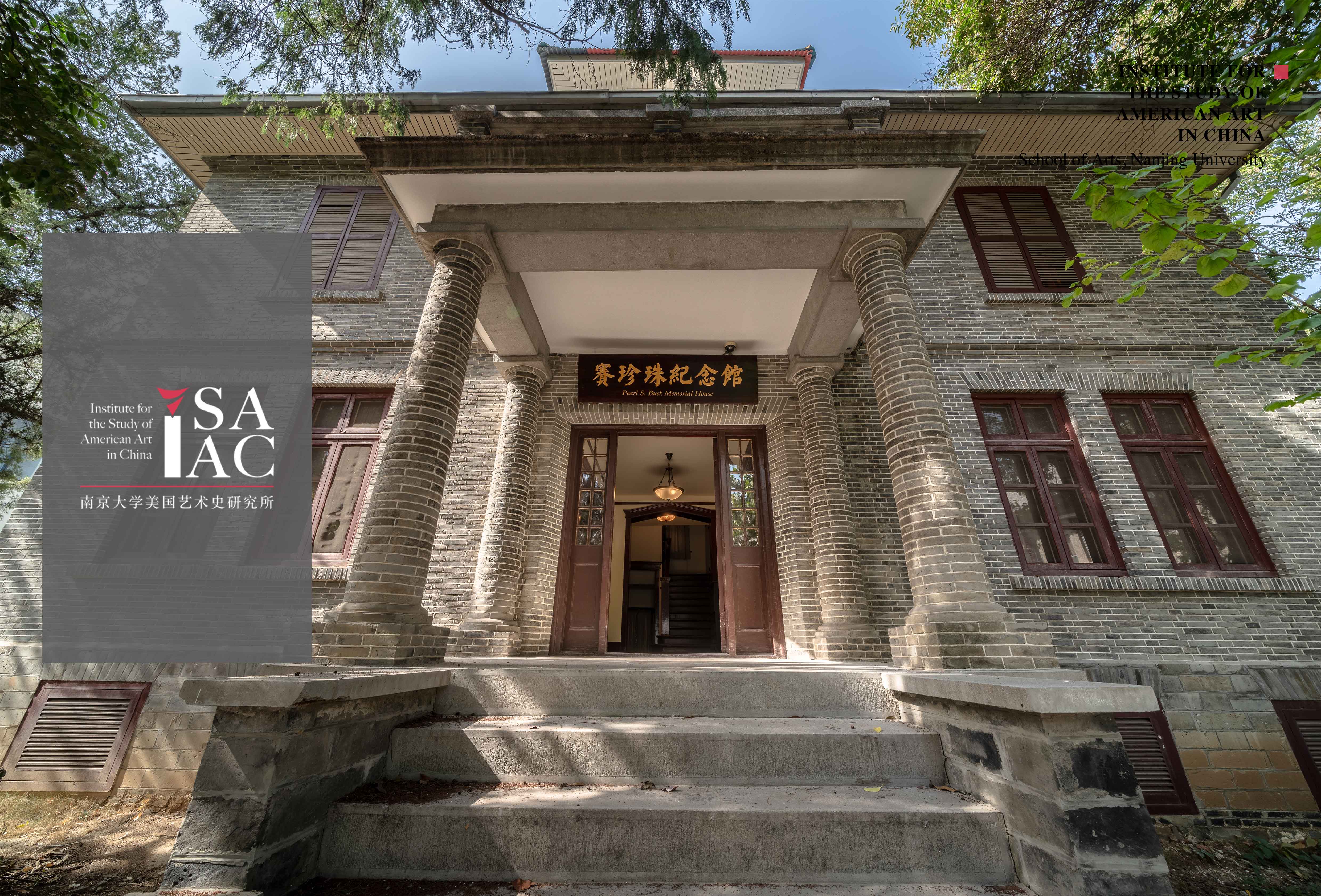
Institute for the Study of American Art in China, School of Arts, on the campus of Nanjing University, China
IN THE YEARS BEFORE RICK’S PASSING, one of his most treasured projects was the establishment of ISAAC—the Institute for the Study of American Art in China. His passion inspired all who got close to the project. Here, for the first time, was a program that would bring the breath of American creativity to the Chinese people. The main association existed between the University of Texas at Dallas, EODIAH and the University of Nanjing. Both the Terra Foundation and the Amon Carter Museum of American Art served as supporting partners in the three-year pilot program.
None of us (except Rick and his visionary intuition) could have imagined the success of the pilot program and the decision of Nanjing University administrators to convert the Pearl S. Buck House on their campus to the ISAAC headquarters. One of Rick’s last wishes—a dream really—was to bring a world-class library of American art to the ISAAC headquarters.
This library would significantly enhance the current achievements related to ISAAC curriculum, publications and academic programs. Before his death, Rick identified a library of approximately 10,000 volumes that had been compiled over a career by the art historian, William H. Gerdts. Professor Gerdts was an American art historian and former Professor of Art History at CUNY Graduate Center, where he taught a generation of Americanists who have literally defined the field.
The Gerdts library is legendary in the field of American art; it will instantly be the most important resource for the study of American art in China and ISAAC will make an ideal home. Today, following in Rick’s footsteps, we are ardently looking for funds to purchase this library. Nanjing has agreed to pay for its transport and half of its cost. The other half will come from our efforts and those of ISAAC’s American partners.
Andrew Walker, Director, The Amon Carter Museum of American Art, Fort Worth, Texas
Pierrette Lacour, Program Coordinator, The Edith O’Donnell Institute of Art History, Dallas, Texas
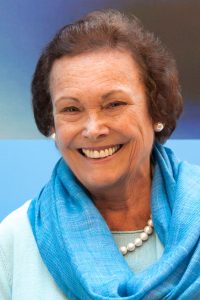
Bonnie Pitman, Distinguished Scholar in Residence, UT Dallas
BONNIE PITMAN’S EXPLORATION OF new intersections between art and science at UT Dallas continues to flourish with her research on Art and Medicine, connections between art history and science with a focus on health, healing, and medical education, and The Power of Observation™, the merger of art with brain science using a framework for deep looking to lead to deeper understandings.
Artists’ Response in a Pandemic: COVID-19 and Influenza 1918
Bonnie’s EODIAH Workshop Talk of the fall featured her new research on art and pandemics. Reflecting on the renewed public interest of historical pandemics in light of COVID-19, her virtual talk explored how artists of the early twentieth century responded to the Spanish Flu of 1918-1920 through traditional media such as documentary photos, billboards, and painted portraits of friends and family, as compared to Contemporary artists’ use of new media and social networks to reach wide audiences. In contrast to the paintings of Edward Munch and Egon Schiele, artists who experienced tremendous loss during the turbulent days of the Spanish Flu, the immediacy and intimacy of new media communicates artists’ more direct, personal feelings of loneliness and the physical emptiness of space, as well as documents COVID-19’s impact on individual victims and communities. Watch the full recording here.
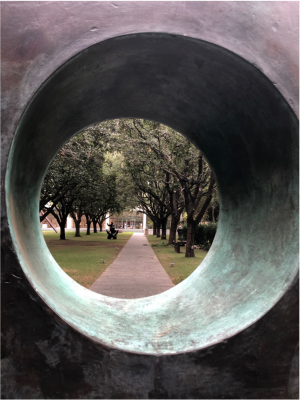
View through Barbara Hepworth, Squares with Two Circles (Monolith), 1963 (cast 1964), Bronze, Raymond and Patsy Nasher Collection; Nasher Sculpture Center, photograph Bonnie Pitman 2020
Nasher Sculpture Center Art and Health Series
Co-sponsored with EODIAH and the Nasher Sculpture Center, Bonnie gave a series of lectures on Mindful Observation using artwork of the Nasher Sculpture Center. Living in the moment—also called mindfulness—is a state of active, open, intentional attention on the present. Through sessions on Staying in the Moment and Seeing in New Ways, Nurturing Relationships, and The Power of Playfulness, participants were led on a virtual journey through the Nasher Sculpture Center gardens and galleries to practice being fully present in the moment while looking at art. Watch the recordings here.
Classes on Art and Medicine
At the UT Dallas Honors College, Bonnie has been virtually teaching fast-paced, interactive classes on “The Art of Observation” and “Art and Medicine”, introducing students pursuing pre-Med and other degrees in the Sciences to her groundbreaking new method of close looking at art. While limited to only virtual meetings, the classes are highly successful in improving students’ abilities to analyze and appreciate art, identifying personal bias, exploring the science of seeing and thinking, and practicing collaborative discourse using objects from the Dallas Museum of Art’s collection online. Her class with UT Southwestern medical students is also held virtually, using the power of art to develop vital skills for clinical diagnosis through practices of close visual inspection and reflection of those observations.

Richard R. Brettell, Edith O’Donnell Institute of Art History Founding Director, and Edith O’Donnell, Edith O’Donnell Institute of Art History Founder
Individual Donors
Jack Adleta, Adeeb Alomar, Ellen Badone, Anne Banter, Dolores Barzune, Mr. and Mrs. Selly Belofsky, Kathryne Bishop, Ann Bjornson, Suzanne Blier, Mary Bloom, Carol Brettell, Ellen Brettell, Henry and Gilda Buchbinder, Stuart Bumpas, Tom and Jeanne Campbell, Constance Clement, Jeanne Marie Clossey, Nancy Cohen Israel, Phyllis Coit, Simon Cook, Trammel Crow, Harlan Crow, Lee Cullum, William and Linda Custard, David E. Daniel, John Dayton, Alexandre de Vogüe, Nancy Dedman, Charron Denker, Mary Dibbern, Barbara Divver, Patricia Farman-Farmaian, Alison Farrow, Regen Fearon, Jerome Frank Jr., Beverly Freeman, David Frieder, Dario Gamboni, Lawrence Gill, Alan J. Greenberg, Gloria Groom, Richard Gutman, Jeremy and Nancy Halbreich, Howard Hallam, Patricia Harmon, Linda Henderson, Amy Hofland, William Howze, Racheale Hulsey, William Jeffet, Bryan Jepson, Dan Jester, Herbert Kessler, Douglas Klahr, Joseph Kobylka, Stephen Koch, Rebecca Krause, Jonathan and Janet Kutner, Pierrette Lacour, Jonathan Langsner, George and Schatzie Lee, Eric M. Lee, John Ridings and Carole Lee, Matilda Louree, Harry and Christina Lynch, Mary Mc Dermott-Cook, Alleen Manning, Maya Manny, Susan Marcus, Heather Marcus, Ed Marquand, Mr. and Mrs. David F. Martineau, Kade Matthews, Quin Matthews, James M. Mincey, Amy Monier, Kathleen Morris, Norman Mueller, Ruth Mutch, Beth Newman, Kim Noltemy, Margaret Owen, Jay and Ruthie Pack, Patricia Patterson, Margot Perot, Roxanne Phillips, Bonnie Pitman, Hervey Priddy, Mary Anne Redmond, Serena Ritch, Cornelia W. Ritchie, Mark Roglan, Susan Rossen, Lizzie Routman, Fabienne Ruppen, Capera Ryan, Katrina Saunders, George Schnerk, Nancy Shutt, John Solana, Willard Speigelman, Carlin Stamm, Salle Stemmons, Gayle Stoffel, Emily Summers, Joseph Takahaschi, Barbara Thomas Lemmon, Mary Vaccaro, Sharman Vesecky, Peter Walker, Rhonda Walls, Howard and Karen Weiner, Jane Wetzel, Charlotte T. Whaley, Kirk Whilelmus, Elaine Whitney, Hobson Wildenthal, David Wilcox, Beth Wright.
Foundations
Amon Carter Museum of American Art, The Arnold Companies, The Harry S. Bass Foundation, The Boeckman Family Foundation, Christie’s, Communities Foundation of Texas, Dallas Jewish Foundation, Fidelity Charitable Gift Fund, The Horchow Family Management Trust, The Howard Hallam Foundation, Huselton, Morgan & Maultsby, Raymond James Charitable Fund, ISAAC, The University of Nanjing, China, The Kimbell Art Foundation, The Kress Foundation, Lock Lord, LLP, The Eugene McDermott Foundation, The James D. and Kay Y. Moran Foundation, The O’Donnell Foundation, The Perot Foundation, Schwab Charitable Fund, Southern Methodist University, Texas Art Collectors Association, Vanguard Charitable Fund.
Support EODIAH
For more information, call Pierrette Lacour at (972) 883-2475, email [email protected] or visit our website.
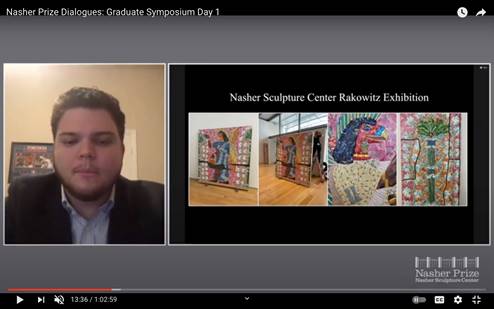
MA Student Austin Bailey presented on Michael Rakowitz at the 2020 Nasher Prize Graduate Student Symposium
THIS YEAR THE MA PROGRAM IN ART HISTORY entered its third year. Students from the second cohort, Craig Cole, Austin Bailey, Megan Refice, and Mya Adams presented their research on Man Ray’s films (Cole), Michael Rakowitz (Bailey), and WPA-era murals in San Francisco (Refice) and Hawaii (Adams) at the annual MA Practicum Workshop in the fall.
In addition to pursuing research assistantships at the Dallas Museum of Art and the Crow Collection, MA students also participated in programs outside EODIAH. Austin Bailey presented on Michael Rakowitz at the 2020 Nasher Prize Graduate Student Symposium, while Mya Adams became the first student to come through via UTD’s fast-track program, which allows talented undergraduates to pursue a graduate-level study during their senior year at the university.
This year’s cohort, Sara Scherper and Meagan Severson, come to EODIAH from the Nasher Sculpture Center and the Crow Collection of Asian Art, respectively, and are currently completing coursework before embarking on thesis research.
We look forward to welcoming current and new Master’s students to campus this fall. There is still time to apply for the 2021-2022 academic year.
ONE OF THE STRENGTHS of the O’Donnell Institute has always been dynamic in-person events: collection tours, workshop talks, lectures, and symposia. We started the year 2020 with a groundbreaking lecture by the late Rick Brettell and his research assistant Elipida Vouitsis, on the iconic work by Paul Gauguin, “D’où venons-nous? Que sommes-nous? Où allons-nous?: New thoughts on pictorial invention.” A rapt audience sat shoulder to shoulder in Horchow Auditorium at the Dallas Museum of Art, listening to what would be Rick’s last public lecture. Thankfully we recorded this talk, and it is available in our new Digital Programs Library on the EODIAH website along with links to many of his other public talks, conversations, and publications. Watch the recording here.
After in-person workshops in early 2020 by DMA curators Drs. Vivian Li and Mark Castro, as well as stalwarts in the field of Roman art and archaeology, Drs. John Clarke and Elaine Gaza, by mid-March we pivoted quickly to close our physical doors and open our virtual ones.
Summer 2020 brought a series of virtual talks in partnership with our Naples Research Center, Centro per la Storia dell’Arte e dell’Architettura delle Città Portuali (La Capraia), featuring long-form digital lectures by well-known Italian scholars exploring art and architecture on the Bay of Naples from antiquity to today. Paolo Giulierini, Director of MANN (Museo Archeologico Nazionale di Naploli) spoke about the famed museum of antiquity and its aims to redefine its role as a center of cultural exchange within the local and global community. Bianca de Divitiis, Associate Professor of Art History, Università degli Studi di Napoli Federico II, reframed Renaissance architecture in the Italian south, and Andrea Viliani, Head and Curator of Castello di Rivoli Research Institute, told the story of the formation of the contemporary art collection at the Museo di Capodimonte, all recorded and archived in our Digital Program Library to watch here.
While virtual talks and lectures can never replace the dynamic exchange that happens in front of a work of art or around a seminar table, going virtual has given us the benefit of recording and archiving these scholarly conversations, for viewing and reference for years to come. Moreover, they have allowed participation from colleagues and scholars all over the world who perhaps could not have flown in for a lecture, but can certainly attend over Zoom. In many ways this has widened our reach, and opened up access for broader participation and involvement.
Fall 2020 saw talks from esteemed colleagues such as Dr. Jacqueline Chao, Senior Curator of Asian Art at the Crow Museum of Asian Art of The University of Texas at Dallas, our own Bonnie Pitman, Distinguished Scholar in Residence at the O’Donnell Institute and Director of Art-Brain Innovations at the Center for BrainHealth, and Dr. Katherine Brodbeck, Hoffman Family Senior Curator of Contemporary Art at the DMA. Drs. Sarah Kozlowski and Mark Rosen, Associate Director of EODIAH and Associate Professor, respectively, wrapped up the year 2020 with complementary talks on Early Modern art; Dr. Kozlowski with a riveting new look at the Stuttgart Apocalypse Panels from 14th century Naples, and Dr. Rosen with a close look at images of clouds and their role in early modern cartography. Browse the recorded lectures here.
Released periodically over the course of the Fall semester, in partnership with the Athenaeum Review, we hosted a timely series of interviews centered on the notion of monuments and cultural heritage, entitled, “Falling and Rising: Public Monuments and Cultural Heritage in a Time of Crisis.” Featuring short interviews with art historians, historians, and archaeologists, we examined the current cultural moment of renewed attention to the role of public art. Catch up on the episodes here.
All in all, as we look to the bright future of a post-pandemic world, we are all eager to get into the energizing space of the museum, gallery, and classroom. We hope to be among the first to open safe, in-person programming. But we also hope to keep the best of virtual events, keeping the ability to open up participation from our friends and colleagues around the world. Stay up to date and register for upcoming events, and peruse our Digital Program Library here.
Heather Bowling
Research Coordinator
The Edith O’Donnell Institute of Art History
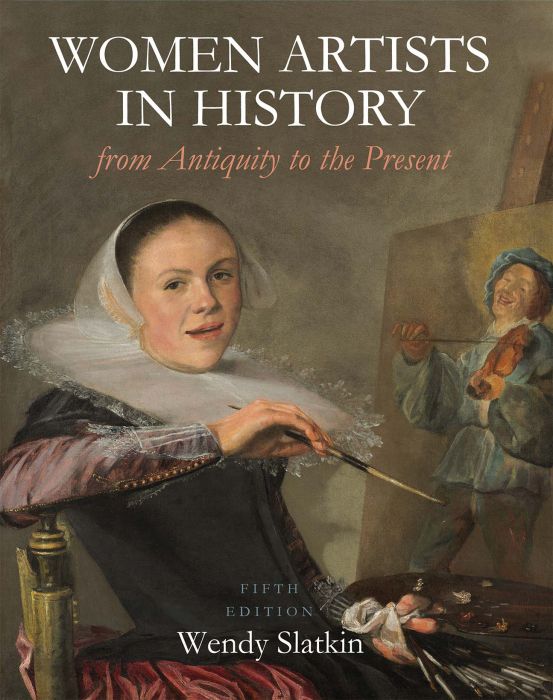
Women Artists in History: from Antiquity to the Present by Wendy Slatkin
DR. CHARISSA TERRANOVA, Professor, The University of Texas at Dallas, has revamped AHST 2331 Understanding Art, an introductory core course primarily for non-humanities students, using the textbook Women Artists in History: from Antiquity to the Present by Wendy Slatkin. Her avid and vivacious TA is Linda Anderson, a PhD student in Visual and Performing Arts. Because of its new and distinct space-time constraints, teaching remotely has given Dr. Terranova the opportunity to rethink the course through the framework of strong women across the ages, be they artists, patrons, historians, or creative writers.
The Bloomsbury book series, Biotechne: Interthinking Art, Science, and Design, coedited by Dr. Charissa Terranova and Professor Meredith Tromble, launches February 10 at the annual meeting of College Art Association, which is online this year. The series publishes books about the history, theory and practice of art and design as they comingle with the natural sciences. The series title reclaims the Greek meanings of the roots bios, conveying life, the living, or citizen-life, and techne, conveying art, skill, or craft. Biotechne thus names the folding of “art” and “science” into complex and hybrid practices that transcend a human-centered “engineering” worldview. “Interthinking,” a neologism invented by art and science visionary György Kepes, describes knowledge informed by ecological, systemic, and cybernetic connections, defining the active engagement among fields central to the Biotechne series. This engagement is the source of the cultural creativity and resourcefulness necessary to thrive in the rapidly changing world conditions of the Anthropocene. Biotechne welcomes proposals treating art and design subjects from any time period, antiquity to the present, which speak directly to these contemporary concerns. Terranova and Tromble seek inventive, cross-pollinating works about the arts and their engagement with sciences from astrobiology to zoology, wherever that engagement occurs, in art or design studios, scientific laboratories, natural habitats, the museum and gallery worlds, performance spaces, medical practices, and the political realm.
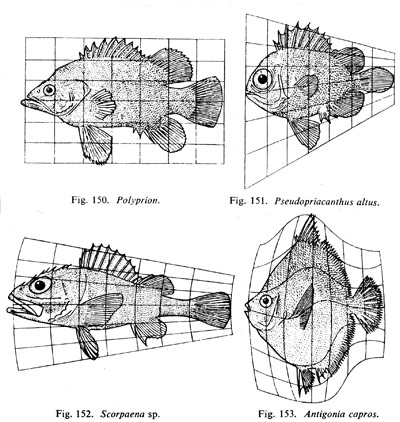
Image from D’Arcy Wentworth Thompson’s On Growth and Form
D’Arcy Wentworth Thompson’s Generative Influences in Art, Design, and Architecture: From Forces to Forms, an anthology coedited by Dr. Charissa N. Terranova and Ellen K. Levy, is set for publication release on March 11, 2021 on Bloomsbury Publishing. It is a collection of essays by artists, scientists and designers about the Scottish zoologist D’Arcy Wentworth Thompson’s 1917 book, On Growth and Form. Thompson’s book continues to evolve a century after its publication, aligning it with current developments in art and science. Practitioners, theorists, and historians from art, science, and design reflect on his ongoing influence. Overall, the anthology links evolutionary theory to form generation in both scientific and cultural domains. It offers a close look at the ways cells, organisms, and rules become generative in fields often otherwise disconnected.
Dr. Terranova convened the panel Real Time Evolution: Art, Culture, and the Lived Now of Climate Change at the annual meeting of College Art Association, which met in February online. She gave a talk about autopoiesis in contemporary art-and-biology. The three other panelists, Kirsten Strom, Ellen K. Levy, and Meredith Tromble, gave talks on wide-ranging topics, from Charles Darwin and surrealist painting to evolution within twenty-first-century art schools.
Terranova is also coeditor with Meredith Tromble of the Bloomsbury Publishing book series Biotechne: Interthinking Art, Science, and Design. For those interested in submitting a related manuscript, please see description below and send inquiries to [email protected].
Biotechne: Interthinking Art, Science and Design
Bloomsbury Publishing Book Series
Charissa N. Terranova and Meredith Tromble, Editors
Biotechne: Interthinking Art, Science and Design publishes books about the history, theory and practice of art and design as they comingle with the natural sciences. The word “biotechne” brings together the Greek word bios, meaning life, the living, or citizen-life, and techne, meaning art, skill, or craft. This word names explorations into hybrid combinations of the living and nonliving, organic and artificial as they manifest between art-and-design studios, scientific laboratories, natural habitats, the museum and gallery worlds, performance spaces, medical practices, and the political realm. “Interthinking,” a neologism invented by art-and-science visionary György Kepes, describes knowledge informed by ecological, systemic, and cybernetic connections, all pivotal concepts for the Anthropocene. Interthinking identifies the active engagement between fields central to the Biotechne series.
Biotechne welcomes art and design subjects from any time period, antiquity to the present, that speak directly to these contemporary concerns. By identifying significant intersections of art and science, and tracking rigorous paths through the transdisciplinary information jungle, Biotechne appeals to audiences of both experts and lay readers from the arts, humanities and sciences. It focuses on inventive, cross-pollinating works about the arts and humanities and their engagement with sciences such as astrobiology, astronomy, biophysics, chemistry, embryology, environmental ecology, evolutionary theory, genetics, information theory, marine biology, microbiology, physics, physiology, zoology and more. Biotechne opens new creative fields of design-based function and analysis that better complement our rapidly evolving world, taking the arts and humanities into new areas of problem solving and critical commentary, while substantiating the role of aesthetic insight within the natural sciences.

“A View from the Balloon,” from Airopaidia Chester, 1786
MARK ROSEN CONTINUES TO SERVE AS Associate Dean for Undergraduate Studies in the School of Arts and Humanities, and just finished serving a two-year term as President of the Italian Art Society. He’s recently published a review essay on Leonardo da Vinci for our own Athenaeum Review (“What We Talk About When We Talk About Leonardo,” Athenaeum Review 5, 10–18) that dovetails with a class taught for UT Dallas in fall 2020 on the artist. Access the article here.
Also published recently is “Worlds Apart: The Four Continents and the Civitates orbis terrarum,” in the edited volume Gendered Bodies and Maps: Personifications of the Continents, eds. Maryanne Horowitz and Louise Arizzoli (Leiden: Brill, 2020). For the upcoming Renaissance Society of America conference in April, he will expand upon a paper he workshopped with EODIAH in November, on the topic of cartography and clouds.
He looks forward to the resumption of in-person classes, seminars, and lectures!
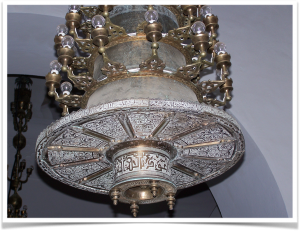
Ali Alibhai is currently working on his book project, entitled, Sacred Sound and Symbolism in Medieval Islamic Society: The Bell-lamp and the Adhān
Dr. Ali Alibhai, Visiting Assistant Professor at the O’Donnell Institute, is currently working on his book project, entitled, Sacred Sound and Symbolism in Medieval Islamic Society: The Bell-lamp and the Adhān. Analyzing sound from the perspectives of Muslims and Christians, this book is the first comparative study of its kind on the subject of the public expression of different aural and visual forms of sacred sound in medieval Islamicate societies. For Muslims, this sacred sound was the adhān, an oral rite consisting of vocalized formulas recited by a muezzin to signal the prescribed times for communal prayer. For medieval Christians living in the Near East and eastern Mediterranean basin, the beating of semantra (wooden boards), and in the west, the ringing of bells were common rituals that called the faithful to gather.
As cultural and geopolitical circumstances changed in different eras and regions of the Islamic world, so did the nature of Muslim and Christian interaction and coexistence. As a result, meanings and symbolism attached to sacred sound in these societies also evolved, changing both soundscapes and visual cultures in medieval Islamic society. Sacred Sound and Symbolism is a historical analysis and comparative study of the evolving meanings of the adhān and the bell in medieval Islamic civilization through interdisciplinary research derived from historical, material cultural, art historical, and religious documentation and sources. It is also the first monograph to closely study the persistent medieval Maghribi Muslim tradition of forging metal mosque lamps made from appropriated Christian bells between the tenth and fourteenth century.

Minecraft architecture of the medieval ruins of the Umayyad palace city of Madinat al-Zahra
This past fall, Alibhai taught a new class at UTD on the art of medieval Islamic Spain. The class surveyed the history, art history, and material culture of ancient and medieval Spain spanning across several centuries. Students explored several aspects of Roman, Visigothic, and Islamic Spain. Specific focus was given to how Islamic culture flourished in the medieval Iberian peninsula between 711 and 1492 and how it left a lasting impact on the history of Spain and its visual and material culture. Themes of art history, numismatics, social history, architecture, engineering, agriculture, geography, and political history were also discussed. Many students who took this class produced creative projects to accompany their final research. These projects ranged from comic books, animations, Minecraft recreation of medieval monuments, and digital 3d modeling.
Ali Alibhai holds a PhD from the Near Eastern Languages and Civilizations department at Harvard University (November 2018). He is a scholar of the histories and cultures of Muslim societies and focuses his research on the medieval Maghrib and Mediterranean worlds, with specializations in the histories and art and architecture of medieval Tunisia, Sicily, Spain, and Morocco. Ali’s academic work combines the study of textual and historical studies with art and architectural history to further understand the socio-cultural history and material culture of the medieval Islamic world. He is currently a Visiting Assistant Professor in Art History at the University of Texas at Dallas and the Edith O’Donnell Institute of Art History.

Dr. Elizabeth M. Molacek, Visiting Scholar, The University of Texas at Dallas
ALTHOUGH COVID PUT A STOP TO international research, Dr. Elizabeth Molacek, Visiting Scholar at the O’Donnell Institute and UT Dallas, made the most of the situation by doubling down on lingering publications.
In May, her article, “Re-Discovering Roman Wall Painting at Harvard: New Research on a Fragment from the Villa at Boscotrecase” was published in the journal Studies in Conservation. The article, co-authored with conservators and materials scientists at the Straus Center for Conservation at Harvard Art Museums, presents a historical and scientific analysis, as well as the conservation treatment of a newly rediscovered Roman wall painting fragment that comes from what is widely considered an Imperial villa in the Bay of Naples.
In January, Molacek was invited to present her ongoing research with a group of international mosaic scholars on the Gold Medal Panel in Honor of Professor Katherine Dunbabin, at the 2021 Meeting of the Archaeological Institute of America. Portions of that research on mosaics and cultural identity at Antioch-on-the-Orontes, will be released later this year in the Festschrift, A Quaint & Curious Volume: Essays in Honor of John J. Dobbins (Archaeopress, 2021).
Arts “Exchange: Media, Movement, and Meaning in Ancient and Medieval Surface Decoration”
Molacek is also guest co-editor with Vanessa Rousseau of a special issue of the journal Arts “Exchange: Media, Movement, and Meaning in Ancient and Medieval Surface Decoration.” A list of current papers can be viewed on the publication website.
For those interested in submitting an article, please see the description below and direct inquiries to [email protected].
At a moment when our world is hyper-focused on how people, things, and ideas move between geographies, surfaces, and spaces, we turn to the ancient world to understand instances of visual, technical, and material exchange as manifest in ancient surface decoration. Purposefully diverse in terms of chronology, geography, and cultural purview, the contributions in this Special Issue should address the many mechanisms that propelled the transfer and transmission of artistic concepts, themes, motifs, and decorative schema in ancient painting, mosaic, stucco, textile, and other surface media. Our goal is to foster diverse perspectives, encourage collaboration, and promote critical discourse among those working on the topic of ancient artistic exchange, interchange, and intersections, and we are particularly interested in contributions that spotlight multiple media, time periods, or geographies.
Dr. Elizabeth Molacek is an art historian whose research, teaching, and curatorial work centers on the art and architecture of Greek and Roman worlds as well as the history of excavating and collecting in the U.S. and Europe. Elizabeth holds a Ph.D. and M.A. from the University of Virginia, a B.A. from Rice University, and completed her postdoctoral training at the Harvard Art Museums.
Elizabeth is a specialist in Roman wall paintings (c. 100 BCE-200 CE) as well as Hellenistic and Roman mosaics, namely from Antioch and the environs. She often collaborates with conservators and conservation-scientists to understand the material aspects of wall paintings and mosaics. Her current project traces wall painting fragments from excavations, through the art market, to museums in the U.S. Her work has been supported by the Getty Research Institute, the AAMD, and the American Academy in Rome, among other institutions.
Prior to Dallas, Elizabeth worked in the Department of Asian and Mediterranean art at the Harvard Art Museums. In this role, Elizabeth contributed to the international loan exhibition and accompanying catalogue, Animal Shaped Vessels and curated the special collection, Roman Domestic Art. She also worked extensively with colleagues in the Straus Center for conservation, including spearheading the conservation and installation of a never-before-exhibited Roman wall painting fragment from the so-called imperial villa at Boscotrecase. She also led the acquisition of several mosaics excavated from the site of Samaria. In addition to her curatorial work, Elizabeth has worked in university administration and taught both traditional (classroom) and on-site (study abroad) courses in which she always prioritizes close encounters with objects.

Dr. Whitney Stewart, Assistant Professor of History, UT Dallas
Whitney Stewart, Assistant Professor of History, The University of Texas at Dallas, has an article coming out in the premier material culture journal, Winterthur Portfolio. In it, she examines objects found within three dwellings on a plantation in North Carolina, and reveal how those artifacts illuminate the home-making strategies of the plantation’s enslaved residents. “A Protected Homeplace: The Material Culture of Home-Making for Stagville’s Enslaved Residents,” Winterthur Portfolio 54, no. 4 (Winter 2020). Pictured: One of the objects Stewart investigates: a walking stick crafted by an enslaved man in the eighteenth century.
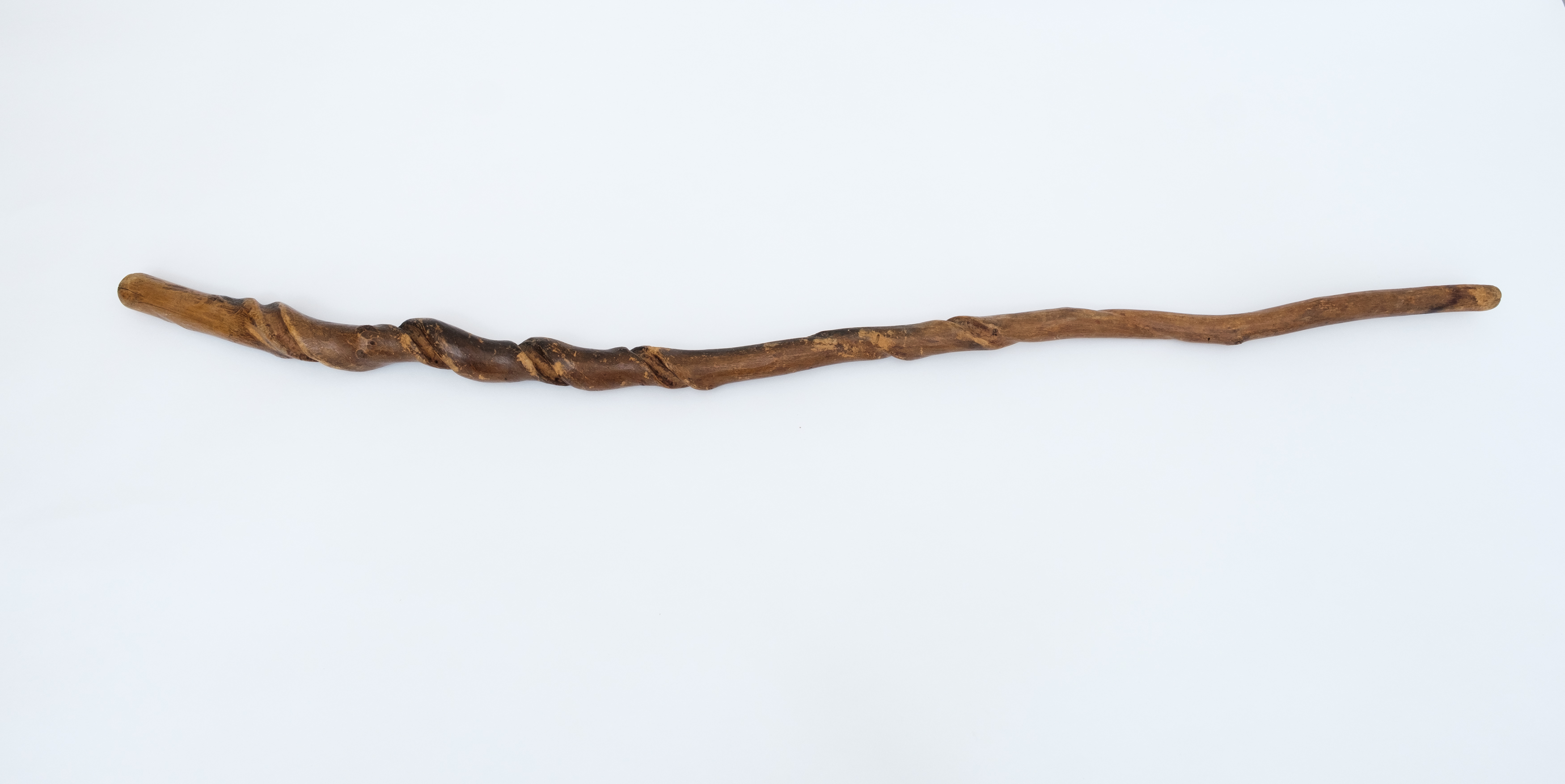
One of the objects Stewart investigates: a walking stick crafted by an enslaved man in the eighteenth century

Patricia Stout, EODIAH Research Fellow
O’Donnell Graduate Fellow Patricia Stout, who is currently working on the completion of her dissertation entitled “Aesthetics and Politics: Community-Based Art in Brazil,” has been selected to present research related to her dissertation at three virtual conferences during the 2020-2021 academic year.
In December, she was invited to participate in a panel entitled Agents of Social Change: Performance Art, Public Art, Street Art, and Social Practice in the Age of Resistance at SECAC (formerly known as the Southeastern College Art Conference). Patricia presented her paper “Eyes on the City: JR’s Women Are Heroes Project in Rio de Janeiro,” which focused on research from the third chapter of her dissertation. In her presentation she examined JR’s Women Are Heroes (2008-2009) project in Rio de Janeiro, Brazil, in which the French artist combined photography with architecturally-based community art to create a favela hillside of women’s eyes gazing down on the city. Her presentation highlighted ways in which JR’s community-based art project made visible particular members in society and called for social change within the city of Rio de Janeiro.
Most recently, Patricia collaborated with Dr. Monica Salazar, a former O’Donnell Graduate Fellow, to organize and co-chair a panel entitled Reimagining Landscapes in a Time of Crisis: Contemporary Latin American Art in Dialogue with the Natural World at the College Art Association (CAA) 2021 Annual Conference. In alignment with this year’s conference theme on the Climate Crisis, the panel explored how contemporary Latin American artists have established new ways of engaging with issues related to nature, the global climate crisis, and what it means to live in a more globalized society by creating interactive artworks both inside and outside traditional gallery spaces. The virtual conference was held on February 10-13, 2021, and the panel’s online Q&A session took place on Saturday, February 13, in which panelists discussed the works of Brazilian artists Néle Azevedo and Sandra Cinto, Chilean-born artist Cecilia Vicuña, Mexican-born artist Margarita Cabrera, and Polish-born Brazilian artist Frans Krajcberg.
Other presenters on the panel included Dr. Elizabeth Varela, former Curator of Research and Documentation at the Museum of Modern Art of Rio de Janeiro, and Barbara Tyner, Ph.D. candidate at the Centro de Cultura Casa Lama in Mexico City. Patricia’s presentation was entitled “Reflections of Nature in Brazilian Art: Large-scale Participatory Artworks by Néle Azevedo and Sandra Cinto” and highlighted the recent works of both artists, including Sandra Cinto’s mural Landscape of a Lifetime at the Dallas Museum of Art, which was organized by Dr. Anna Katherine Brodbeck, the Hoffman Family Senior Curator of Contemporary Art, and on view at the DMA from November 15, 2019 – November 1, 2020.
In May, Patricia will present research related to her final dissertation chapter on Brazilian artist Vik Muniz as part of the Imágenes, resistencia y negociación panel at the Latin American Studies Association (LASA) 2021 Virtual Congress.
Read more about Patricia Stout’s research and dissertation topic.

Mashhad manuscript, Courtesy of the New York Public Library
Dr. Fatemeh Tashakori, Postdoctoral Research Associate, is at work on the Mashhad Observatory Project headed by Dr. Heather Ecker at The Dallas Museum of Art. Tashakori’s research includes the study and translation from Persian of the charts and accompanying illustrations of constellations in two manuscripts (New York Public Library and Egyptian National Library) of the Tarjumah-i Suwar alKawakib (Book of Fixed Stars) of ‘Abd al-Rahman al-Sufi, produced in Iran in the early 1630s by the astronomer Hasan b. Sa‘ad al-Qa’ini. Dr. Tashakori is responsible for the first modern transcription of the Tarjumah-i Suwar al-Kawakib, which she is carrying out by comparing the New York and Cairo manuscripts with an earlier Persian translation of Nasir al-Din Tusi from the thirteenth century.
Mashhad Observatory Project
In the 1630s, under the enlightened patronage of the Safavid governor of Khurasan (north-eastern Iran), Abu’l-Fath Manuchihr Khan (r. 1625-1636), the astronomer Hasan b. Sa‘ad al-Qa’ini brought together a group of scholars and artists to work on the translation to Persian of the Arabic text the medieval classic, ‘Abd al-Rahman al-Sufi’s Book of Images of the Fixed Stars (BIFS), an expanded commentary of chapters 7 and 8 of the first century Greek astronomer, Claudius Ptolemy. Hasan b. Sa‘ad al-Qa’ini added a new preface to al-Sufi’s text, a statement of circumstances and purpose that bore testimony to the in-gathering of knowledge through the project of translation. In the preface, the body of the text and in the star charts and drawings, Farsi and Arabic are expertly intertwined, presenting an outstanding example of linguistic intertextuality in seventeenth-century Iran. Such intertextuality turns the manuscript into a literary/scientific palimpsest that compiles new with fragments of earlier sources and creates layers of meaning. The language of the preface demonstrates a worldly view of science that aimed to create benefit through scientific exchanges. This view of knowledge and science was brought about under the patronage of Abu’l-Fath Manuchihr Khan, who had a personal interest in science and art and was enthusiastic about the spread of astronomical knowledge for the sake of public good.

Jacquelyn Delin McDonald
Former EODIAH Graduate Fellow Jacquelyn Delin McDonald was invited by the Friends of the Governor’s Mansion to give a presentation during a luncheon scheduled for May 2020. Ultimately, the event was rescheduled and occurred virtually in January. Jacquelyn’s talk titled “’Wild Man’ or Statesman? Elisabet Ney’s Sam Houston” was designed to give the docent members more information about the early Texas governor, the German-American/Texan sculptor, and the sculpture within the collection housed at the Texas Governor’s Mansion.
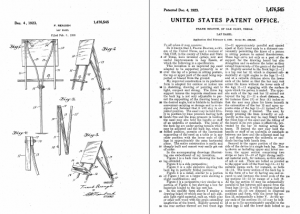
The 1923 patent drawings from Reaugh’s plein air lap easel design
Jouette Travis, The University of Texas at Dallas
My Spring, 2020 independent study was underway with Dr. Brettell when my second trip to The Frank Reaugh art collection in Canyon, Texas was cancelled due to Covid. Frank Reaugh (1860-1945) studied at the Académie Julian in Paris, built two art studios in Dallas, and took his art club out every summer for several weeks of horse and later car camping, to capture landscapes en plein air. He was a teacher to several of the Dallas Nine artists, started the art room at Dallas’ Carnegie Library, and was founder the original Dallas Museum of Fine Arts at Fair Park.
An initial 2019 trip to visit Palo Duro Canyon and the Panhandle & Plains Historical Museum, on the campus of of West Texas A & M University, allowed me to complete my final paper. But with museums closed and curators unavailable for the rest of 2020, progress was redirected over the summer and fall to one of my seven follow up projects. While I had to proceed without Dr. Brettell’s oversight, his interest in Texas artists and in a Museum of Texas Art (MoTA) still motivates me and many others at UT Dallas and around Dallas.
Using the 1923 patent drawings from Reaugh’s plein air lap easel design, I had two easels crafted by a local woodworker, completed December, 2020.
Plein air painting is socially distanced and even though health concerns were not the motivation behind my research into the artist’s tools and methods, creating art out-of-doors may provide artists some needed flexibility in their work environments. My plan for Spring, 2021 is to explore the methods of this pioneering Dallas artist using his original designs. EODIAH introduced me, and many others, to Texas art and artists.
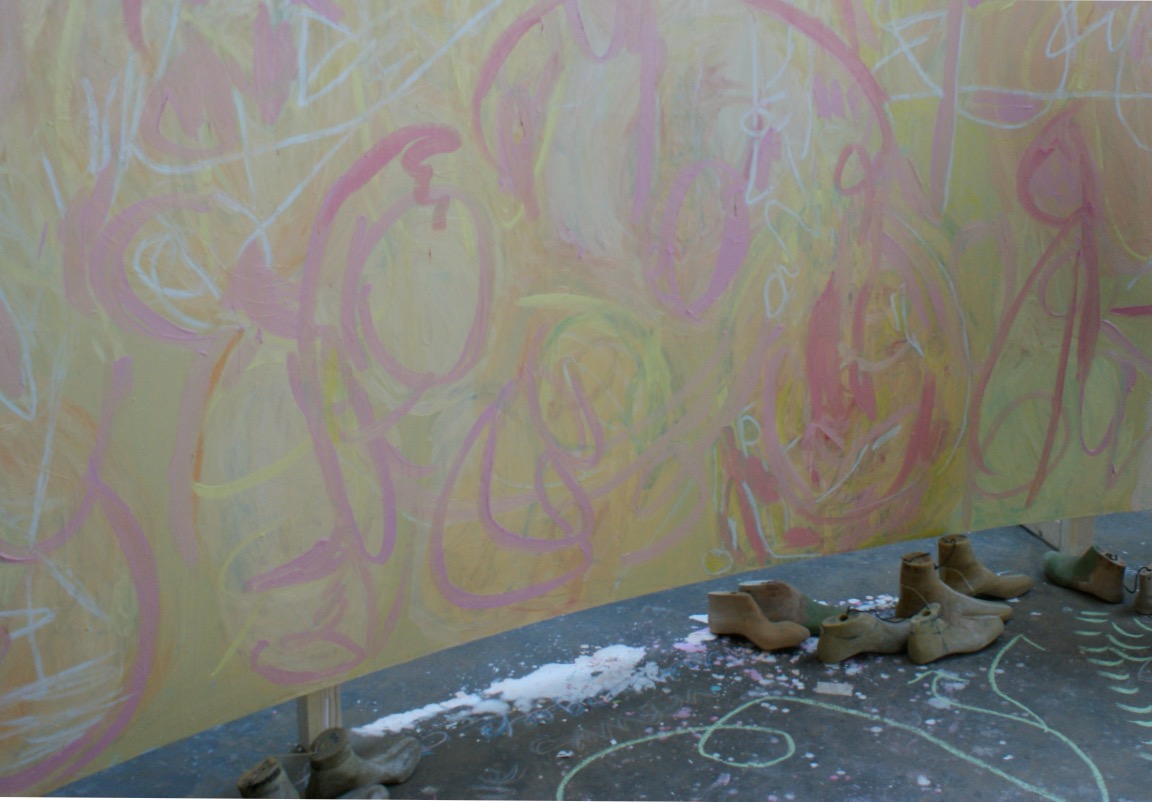
“We Three Retrospective” will be installed at WorkHeart, Kampen, NL in June 2021.
Douwe Buwalda, Bert van der Sluijus and Linda Anderson have worked together since 2008 when they first met at a group show in Enschede, NL. In 2010, they were invited to create an installation at an old academy building in Kampen, NL. “We Three Retrospective” will be installed at WorkHeart, Kampen, NL in June 2021.
The work for the installation involved creating a rotating mechanism with a bent streetlamp post approximately 15 feet long. From this we attached additional mechanical workings to create the scene of a tricycle going round and round.
This retrospective features a number of our other works from 2008 to 2017, the merry-go-round, the large feathers in the fireplace and other installations throughout The Netherlands. The retrospective provides a unique opportunity to see the work of a team of three artists, two Dutch and one American. The photo is from the installation before the shoe lasts were arranged along the bottom of the painting.
An empty tricycle creates a circle on the wood floor, lit by the large windows in an old academy.
The girl’s legs are too short to reach the pedals, wood blocks are added, and her galoshes attached.
The missing seat is replaced by a curved five-pronged hay fork.
The tricycle attached to a tall and curving light pole, guiding her on an increasing circular path, round and round.
In front of her is the poet, writing in Dutch with chalk, as he finishes, the tricycle’s path erases his words.
At the outer edge of the circle sit present children.
Just beyond the ring of children is a semi-circular line of shoe lasts from the men with broken feet.
The lasts are the remembrance of their work.
Behind the lasts stands a semi-circular shaped canvas eight feet high and fifty feet long encircles the scene.
The artist has painted childlike forms in bright pink, yellow and white on the canvas.
As the poet finishes, he gives the children chalk and leads them to the painting.
The children draw as high as they can reach on the lower third of the painting.
The time is 1940 and 2010.
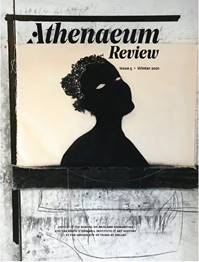
Athenaeum Review Issue 5 features cover art by taylor barnes, Emerge/Imagine, 2020, charcoal and sewing on cloth, courtesy the artist and Erin Cluley Gallery, Dallas.
The winter 2021 issue of Athenaeum Review is out now at athenaeumreview.org.
Among the contents of the new issue are articles on Mark Tobey and Isamu Noguchi by Weiyi Wu, Leonardo da Vinci by Mark Rosen, El Greco by Brian Allen, Nishiki Sugawara-Beda by Robert E. Gordon, and lab notebooks by Elizabeth Molacek and Aaron Fond.
Also in the new issue: artwork by taylor barnes, Riley Holloway, Jammie Holmes, Letitia Huckaby, Sedrick Huckaby, Evita Tezeno, and Desireé Vaniecia, the museums of Iceland, Isicathamiya song in Durban, Cordelia’s silence in King Lear, Ozsváth and Turner’s Goethe, voyaging with Darwin, the art of terraforming, English artifacts, democratic disappointment, classicism by decree, living with hate, Max Weber’s vocation, and poetry by Jane Saginaw, Tom Palaima and Nomi Stone.
The winter 2021 issue of Athenaeum Review is dedicated, with the generous support of Karen and Howard Weiner, to the memory of Richard R. Brettell.
Athenaeum Review is published twice yearly by the Edith O’Donnell Institute of Art History and the School of Arts and Humanities. Featuring essays, reviews and podcasts by leading scholars in the arts and humanities, all issues of the journal may be freely read online, or ordered in print from the UT Dallas Marketplace. For more information, contact [email protected].
Alessandra Comini: Isolation has given Alessandra Comini even more time for writing. I am 2/3s through my NINTH murder mystery, The Brahms Bust, which is, by the way, dedicated to the memory of Rick Brettell. The entire Megan Crespi mystery series is being brought out in German by the same Vienna publisher who just published my scholarly (yes, I still do scholarly things in retirement!) 4-pound, 575-page book on the changing image of Beethoven.
Jessica Fripp, Assistant Professor of Art History, TCU has a new publication: Portraiture and Friendship in Enlightenment France, Jessica L. Fripp (University of Delaware Press, distributed by the University of Virginia Press, 2020).

Kana Harada, Divine Spark (Detail), 2020. Foam sheet and mixed media. 53 x 7 x 9 in. Courtesy of the artist. Photo: Makoto Takemura
DIVINE SPARK
On view January 30 – September 5, 2021
Tokyo-born, Dallas-based artist Kana Harada has forged her own path with artworks that blend messages of hope and positivity with visual innovations that create an imaginative universe of awe, wonder, and intimacy. For her first solo exhibition at the museum, Harada expresses the light that can be found in the dark, and continues to push sculpture, foam, and acrylic and watercolor painting to new heights in her practice.
BORN OF FIRE: CONTEMPORARY JAPANESE WOMEN CERAMIC ARTISTS
On view January 30, 2021
Features a selection of works by living emerging and internationally established Japanese women ceramic artists. This exhibition draws from the collection of Carol and Jeffrey Horvitz, who have amassed an important encyclopedic collection of major Japanese modern and contemporary ceramics. Their collection of over 1,000 works is the largest, public or private, of contemporary Japanese ceramics outside of Japan.
VISHNU: ACROSS TIME AND SPACE
On view January 30, 2021
Through a selection of works of art from the museum’s permanent collection, we invite you to contemplate the multiple facets of this deity. The artistic and visual representations of Vishnu change in style and appearance across time and place, and may look completely different depending on the context.
EVENTS Watch Past Events Online
Divine Spark: Artist Conversation with Kana Harada
Wednesday, March 10, 2021
Senior Curator Dr. Jacqueline Chao and artist Kana Harada discuss her new exhibition.
Lunar New Year In A Flash!
February 12-26, 2021
The Crow Museum celebrates The Year of the Ox online with fifteen days of short digital content designed to celebrate the Lunar New Year at home.
Born of Fire: Contemporary Japanese Women Ceramic Artists Virtual Program
April 2021
Join us for a virtual program featuring our current exhibition, Born of Fire: Contemporary Japanese Women Ceramic Artists. With guest panelists Joan Mirviss of Joan B. Mirviss Ltd, art dealer and Japanese pottery specialist, and Dr. Jacqueline Chao, Crow Museum Senior Curator.

Chris Schanck, Curbed Vanity, mixed media, aluminum foil, and resin. Photo by Clare Gatto. On view at the Dallas Museum of Art.
Curbed Vanity: A Contemporary Foil by Chris Schanck
2/7/21 to 8/29/21 | Free
For his first solo museum exhibition, designer Chris Schanck has created a new work inspired by the 19th-century Gorham Manufacturing Company’s Martelé dressing set, an icon of the DMA’s collection and a monument in the history of American metalwork. Curbed Vanity pairs works in a conversation across time about craftsmanship and material. Now based in Detroit, Schanck was raised in Dallas and graduated from Booker T. Washington High School for the Performing and Visual Arts.
Devoted: Art and Spirituality in Mexico and New Mexico
2/28/21 to 1/2/22 | Free
Featuring over 35 paintings and sculptures from the DMA’s Latin American art collection, Devoted focuses on two distinct but related practices: bultos, wooden sculptures of saints and other holy figures, and ex-votos, paintings that commemorate personal miracles. The exhibition explores the important role these devotional objects—admired as much for their artistic value as for their spiritual significance—have played in communities across centuries.
2/28/21 to 6/20/21 | Free
Through five works, this focused installation explores key aspects of acclaimed Mexican painter Frida Kahlo’s practice, including her unique visual language, exploration of still life painting, and reflection on the events of her adventurous life.
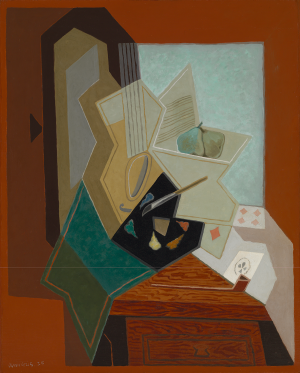
Juan Gris, The Painter’s Window, 1925, Baltimore Museum of Art, Bequest of Saidie A. May. Photography by Mitro Hood. On view in the DMA’s exhibition “Cubism in Color”.
Cubism in Color: The Still Lifes of Juan Gris
3/14/21 to 7/25/21 | Ticket required
Co-organized by the Dallas Museum of Art and the Baltimore Museum of Art, this is the first U.S. exhibition in over 35 years dedicated to the Spanish artist Juan Gris. Cubism in Color: The Still Lifes of Juan Gris highlights the artist’s pioneering and revolutionary contributions to the Cubist movement by focusing on his fascination with subjects drawn from everyday life.
Concentrations 63: Julian Charrière, Towards No Earthly Pole
5/2/21 to 8/8/21 | Free
Julian Charrière creates work that bridges the realms of environmental science and cultural history. This focused exhibition provides immersive encounters with the artist’s melancholic and beautiful portraits of nature in the human era, culminating with his most recent video project, Towards No Earthly Pole.
Keir Collection of Islamic Art
Free
From mid-February through June, selections from the collection, particularly early Islamic talismanic drawings and Coptic textiles from Egypt, will be on display in dialogue with a recent work by the well-known Cairo-based contemporary artist Huda Lutfi on loan from the collection of Marguerite Steed Hoffman. Responding to the unique challenges of our times, the work from 2019-2020 entitled Healing Devices Helpful in Time of Constraints and Anxiety represents a series of 12 small collages inspired by the 100 designs for automata by the 12th-century Arab engineer, Isma‘il al-Jazari. One of al-Jazari’s designs in the Keir Collection is displayed. Other works on view in this rotation include uniquely sophisticated textiles from 16th-century Iran with iconography ranging from dancing ladies in a garden to a representation of the angels and birds of paradise.

Gay Block, Zofia Baniecka, Poland, 1986, archival inkjet print, 24 x 20 in. ©Gay Block. Courtesy of the artist
Comer Collection: “Crafting Cultural Hybridity”
Brought to you by the Marilyn and Jerry Comer Collection of Photography.
This exhibition, which displays Gay Block’s works alongside a selection of photographs from the Comer Collection, explores ideas of identity in marginalized individuals and communities and how photographers negotiate their relationship with said communities as either insider or interpreter. The exhibition is viewable by appointment* at the SP/N Gallery from March 26 – April 24.
Jessica Ingle, Curator, will be giving a virtual walk-thru and curator’s talk which can be viewed throughout the duration of the show.
Gay Block will be giving a virtual lecture on Tuesday, March 30, at 7 p.m. on Zoom. Register here.
*In order to protect the safety of visitors and staff, and to help stop the spread of COVID-19, advance appointments are recommended. A limited number of people will be allowed in the space at one time. To make an appointment: please email [email protected] to schedule your preferred date and time. Wearing a mask is required while in the gallery and visitors are asked to practice social distancing.
SP/N Gallery is located at 3020 Stewart Dr, Richardson, TX 75080 to the right of the Southwest Medical north of UT Dallas campus.

Poster Design and Illustration by Maedeh Asgharpour
20/20 Hindsight
6th Annual Persian Art Exhibition
The Irving Art Association is sponsoring the 6th annual Persian Art Exhibition, an online only exhibition depicting works of art from Iranian artists who live in Texas and neighboring states. 112 works from 42 artists are included in this exhibition. “2020 HINDSIGHT” can be viewed online.
All subjects were open to be entered, but the exhibit theme is a saying by Rumi “Come, let us appreciate each other, because you never know we might be suddenly separated,” (Divan-i Kebir, v. 3, no. 1535). This concept of appreciation can include COVID-related gratitude but is in no way limited to topics related to the coronavirus. Any art submission that touches on the theme of gratitude and/or a deeper sense of appreciation for one’s families and communities was welcome.
The exhibit is curated by Pouran Lashini and juried by Fari Rahimi, Roya Mansorkhni, and Soheyla Rashidyan